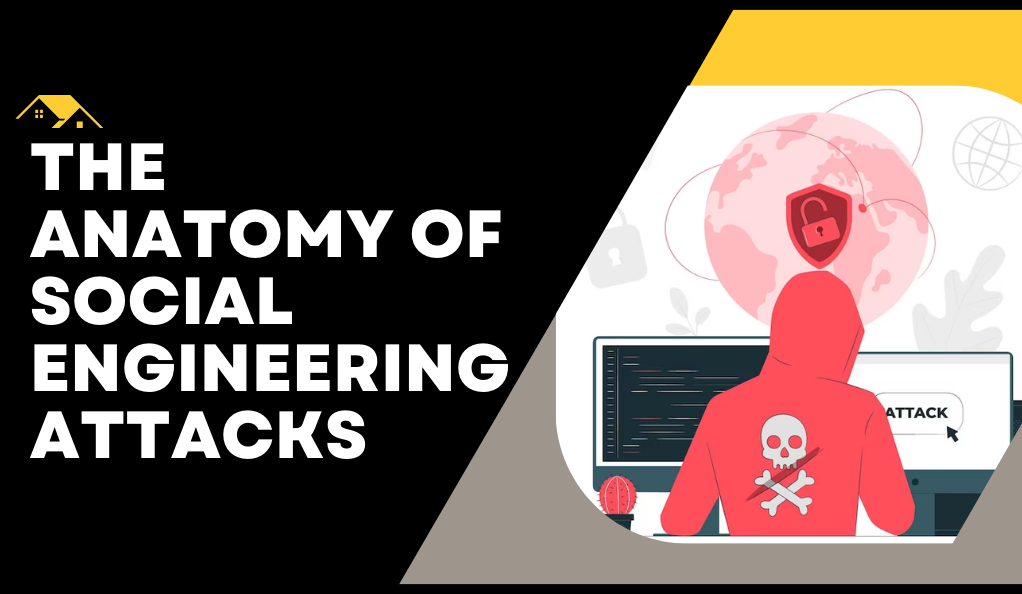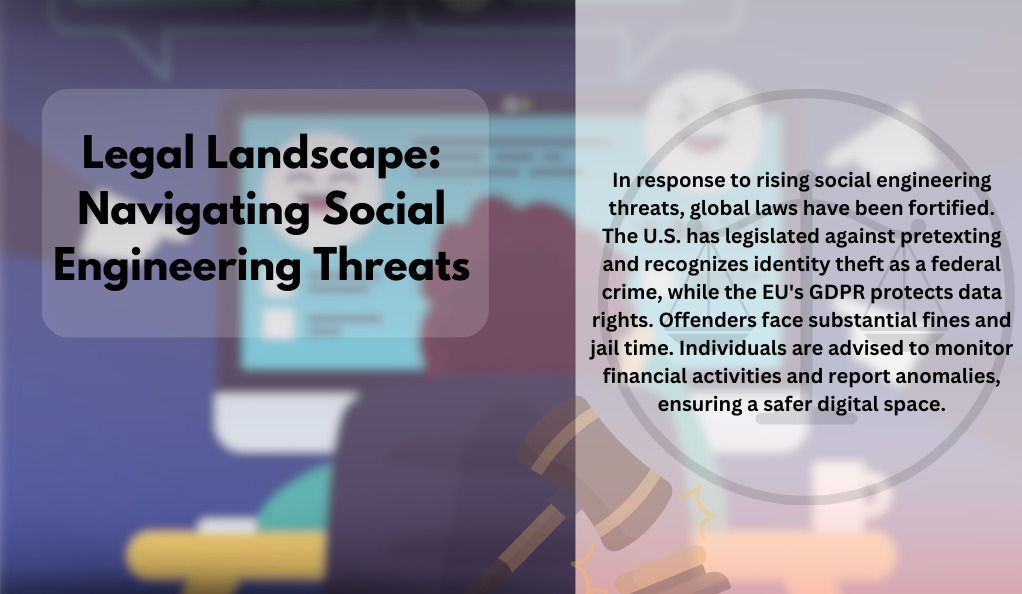In the vast realm of cybersecurity, one of the most insidious and human-centric threats is social engineering. Unlike traditional cyberattacks that focus on exploiting software vulnerabilities, social engineering targets the most unpredictable element in the security chain: the human being.
What is Social Engineering?
Social engineering blends psychology with cybersecurity, targeting human vulnerabilities rather than system flaws. By exploiting trust, curiosity, and our sense of reciprocity, attackers manipulate individuals into revealing sensitive information. These manipulators research their targets extensively, using personalized tactics like phishing or physical intrusion. While our inherent human traits can be exploited, with proper awareness, they also become our strongest defense against such deceptive threats in the digital landscape.
Why is it Significant in the Digital Age?
As our lives become increasingly intertwined with the digital world, the amount of personal and sensitive information available online has skyrocketed. From social media profiles to online banking details, there’s a treasure trove of data that malicious actors crave. And while software and hardware can be patched and updated to fend off threats, the human mind is not so easily upgraded. This makes individuals the weakest link in the cybersecurity chain, and thus, a prime target for social engineering attacks.
The Psychological Manipulation of Individuals
Understanding the psychology behind these attacks is crucial. Social engineers prey on a range of human emotions and cognitive biases, including:
- Trust: Exploiting the inherent trust people place in authority figures or familiar entities.
- Fear: Creating a sense of urgency or panic, pushing individuals to act without thinking.
- Curiosity: Leveraging the human tendency to seek out new or intriguing information.
- Reciprocity: Playing on the desire to return a favor when something is given.
The Anatomy of Social Engineering Attacks

As we venture further into the labyrinth of social engineering, it becomes evident that these attacks are multifaceted, each tailored to exploit specific human tendencies. The anatomy of such an attack is often intricate, designed to be unnoticeable until it’s too late.
The Role of Cognitive Biases in Decision-Making
Every individual, regardless of their background or education, is susceptible to cognitive biases. These are systematic patterns of deviation from norm or rationality in judgment, causing individuals to create their subjective reality from their perception of the input. Social engineers exploit these biases to predict and manipulate a person’s actions. Some of the most commonly exploited biases include:
- Confirmation Bias: The tendency to search for, interpret, and remember information in a way that confirms one’s preconceptions. An attacker might feed information that aligns with the victim’s beliefs, making the deceit more believable.
- Authority Bias: The tendency to attribute greater accuracy to the opinion of an authority figure and be more influenced by that opinion. This is why many phishing emails pretend to be from a company’s CEO or a familiar institution.
- Anchoring Bias: Relying heavily on the first piece of information encountered (the “anchor”) when making decisions. For instance, if the first piece of information a person receives during an attack is a fake ID badge, they might be more likely to trust subsequent false information.
Real-World Examples of Social Engineering Attacks
To truly grasp the depth and breadth of social engineering tactics, let’s explore some real-world examples:
- The Help Desk Scam: An attacker calls an employee, posing as a member of the IT department, and claims they need to verify the employee’s password for a “system update.” Trusting the authority of the IT department, the employee might unwittingly divulge their credentials.
- The Baited USB: Malware-laden USB drives are left in company parking lots or lounges, labeled with enticing tags like “Salary Details” or “Confidential Project.” Curious employees insert them into company computers, unknowingly introducing malware into the system.
- The LinkedIn Connection: An attacker creates a fake LinkedIn profile, posing as a recruiter or an industry professional. They then connect with employees from a target company, slowly gathering bits of information that can be used for a more significant attack.
The Impact of Deception
The aftermath of a successful social engineering attack can be devastating. Beyond the immediate loss of sensitive data, companies face reputational damage, financial penalties, and the long-term impact of breached trust. For individuals, the consequences can range from financial loss to identity theft.
Techniques and Terms
The world of social engineering is vast, with attackers continually evolving their methods to stay one step ahead. To effectively guard against these threats, it’s crucial to understand the various techniques and terms associated with them.
Pretexting: The Art of Creating Scenarios
Pretexting is a method where attackers create a fabricated scenario (the pretext) to obtain personal information. This technique relies heavily on building a false sense of trust with the victim. For instance:
- An attacker might pose as a tax official, claiming they need to verify some discrepancies in the victim’s tax return.
- A scammer could pretend to be a family member in distress, urgently needing financial help.
The key to pretexting is the detailed background story, which often sounds legitimate enough to dupe the unsuspecting victim.
Water Holing: Exploiting Trust in Frequently Visited Websites
The water holing technique involves compromising websites that a target group frequently visits. Once these sites are infected with malware, any visitor from the target group unknowingly gets infected too. The name draws an analogy from predators in the wild who wait near watering holes, knowing their prey will eventually come to drink.
For instance, if an attacker wants to target employees of a specific industry, they might compromise industry news websites or forums.
Baiting: Leveraging Curiosity and Greed
Baiting is similar to the real-world concept of using a bait to catch prey. Attackers lure victims by promising something enticing in exchange for information or access. This could be:
- A free download of a sought-after software.
- A link to “exclusive” news or content.
However, once the bait is taken, malware is installed on the victim’s system or sensitive information is stolen.
Tailgating: Unauthorized Access Through Imitation
Tailgating, also known as “piggybacking,” involves an attacker seeking entry to a restricted area without proper authentication. They achieve this by following an authorized person into the area. For instance, they might impersonate a delivery driver and wait outside a secure building. When an employee opens the door to enter, the attacker asks if they can slip in behind, often with a plausible excuse.
Quizzing: Exploiting the Desire to Help
Quizzing involves an attacker approaching an individual with a series of questions under the guise of a survey or quiz. While some questions might seem harmless, others are designed to extract sensitive information subtly.
Notable Social Engineers

Throughout history, tales of cunning individuals who’ve used charm, intelligence, and deceit to manipulate others have fascinated and alarmed us. In the digital age, the realm of cybersecurity has its own pantheon of such figures, individuals whose audacious acts have reshaped our understanding of vulnerability and deception.
Susan Headley: The Enigmatic Digital Siren
Known in the digital underworld as “Susan Thunder,” Susan Headley’s rise to notoriety during the 1970s and 80s was nothing short of meteoric. A unique blend of striking appearance and unparalleled technical acumen made her a force to be reckoned with. She masterfully breached numerous systems, amassing and then monetizing stolen credit card data. Her alliances with some of the era’s most infamous hacker groups, followed by her eventual double-crossing, cemented her status as a divisive figure in cybercrime lore.
Kevin Mitnick: The Odyssey from Outlaw to Guardian
Kevin Mitnick’s name is synonymous with social engineering. His legendary escapades were so audacious that they earned him a spot on the FBI’s most-wanted list. But Mitnick’s genius lay not just in his ability to breach systems; he was a maestro of human manipulation. He could, with alarming ease, persuade IT professionals to hand over passwords and other guarded information. However, after a stint in prison, Mitnick underwent a profound transformation. Today, he helms a leading cybersecurity consulting firm, channeling his once-misused expertise into safeguarding businesses from threats.
Frank Abagnale: The Shape-shifter Extraordinaire
Frank Abagnale’s story is a departure from the archetypal hacker narrative. In the 1960s, this prodigious con artist donned a myriad of false identities, from airline pilot to physician to attorney. His life, a whirlwind of deception and audacity, was brilliantly captured in the cinematic masterpiece, “Catch Me If You Can.” Abagnale’s escapades underscore the essence of social engineering: exploiting trust and manipulating perception.
Fortifying Defenses: Counteracting Social Engineering
In the face of these master manipulators, awareness emerges as our primary shield. But to truly fortify our defenses, both individuals and organizations must adopt a multi-pronged strategy.
Proactive Identification and Evasion of Threats
- Education: Continuous training initiatives can equip employees with the knowledge to spot and thwart typical social engineering maneuvers.
- Verification Protocols: Instituting a policy of always verifying the credentials of anyone seeking confidential information can act as a robust deterrent.
Bolstering Technological Safeguards
- Two-Factor Authentication (2FA): A dual-layered security measure, 2FA ensures that even if a malicious actor acquires a password, they’re still barred from unauthorized access.
- Encrypted Channels: Promoting the use of encryption for all communication, particularly when it pertains to sensitive data, can significantly reduce the risk of breaches.
Simulated Threat Scenarios
- Mock Drills: Periodically simulating social engineering attacks can serve a dual purpose: assessing the preparedness of employees and highlighting areas that need further strengthening.
Legal Landscape: Navigating Social Engineering Threats

As the specter of social engineering looms larger, global legal institutions and governments have risen to the challenge, fortifying legal structures to counteract these threats. These enhanced legal provisions not only aim to deter malicious actors but also offer avenues of redress for those affected.
Combatting Pretexting and Deceptive Maneuvers
Pretexting, a favored tactic among social engineers, revolves around the acquisition of personal data through deceitful means. Recognizing the gravity of such actions:
- The U.S. legislated the “Telephone Records and Privacy Protection Act of 2006.” This act criminalizes the intentional and unauthorized procurement of phone records without explicit consent from the concerned individual.
- Globally, numerous nations have fortified their data protection laws, imposing stringent penalties on unauthorized personal data access, irrespective of the method of acquisition.
Upholding Consumer Data Rights and Privacy
Beyond specific laws addressing deceptive tactics:
- The U.S. Federal Trade Commission champions the “Identity Theft and Assumption Deterrence Act,” classifying identity theft as a federal offense, thereby amplifying its legal ramifications.
- The European Union’s “General Data Protection Regulation (GDPR)” stands as a bulwark for data protection and privacy rights for all its citizens and those within the European Economic Area (EEA). Moreover, it provides guidelines for the transference of personal data beyond its borders.
Repercussions for Social Engineering Offenders
Engaging in social engineering carries hefty consequences, including:
- Substantial monetary penalties, often determined by the gravity of the security breach and the nature of the compromised data.
- Incarceration, with durations spanning from a handful of years to life sentences, particularly when the transgressions result in profound financial or personal distress.
Empowering Individuals: Proactive Defense Strategies
While the legal realm offers a foundational layer of protection, individuals bear the responsibility of proactive defense:
- Diligently scrutinizing bank and credit card statements to identify and report unauthorized activities.
- Enlisting the aid of credit monitoring services to receive timely alerts about potential anomalies in one’s credit profile.
- Swiftly reporting any suspicious activities or encounters to the appropriate legal or institutional authorities.
Conclusion
In our digital age, social engineering stands as a testament to the vulnerabilities inherent in human nature. While technology advances rapidly, our emotions and biases remain a consistent target for malicious actors. However, our greatest vulnerability can also be our strength. Through awareness and education, we can turn the tables on these attackers.
Legal protections and technological safeguards are essential, but true security lies in our ability to stay informed and vigilant. As we navigate the digital landscape, understanding the tactics of social engineers and fostering a culture of continuous learning becomes paramount.








